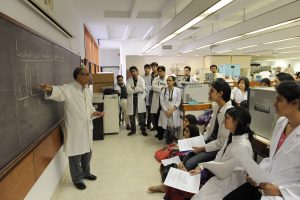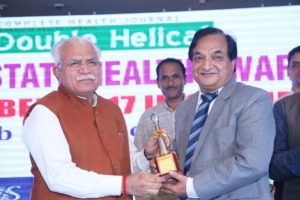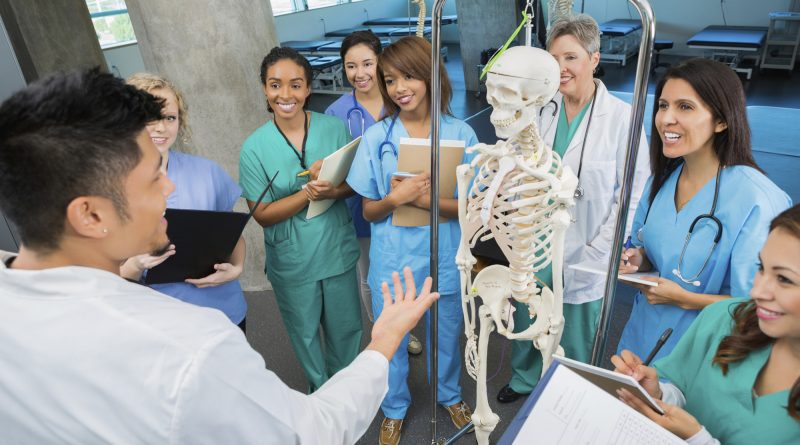Extensive Churning
National Eligibility –cum-Entrance Test (NEET) has come out extensive churning to improve the quality of new entrant to medical profession. The efforts of MCI, Ministry of Health and Family Welfare (Govt. of India) and Hon’ble Supreme Court is undoubtedly laudable to bring all the desirous candidates in our country under one ambit of NEET. Since NEET 2017 is a first experience but the lesson learnt from it would further help in improving the scope of NEET in identifying the good quality of students in medicine…….
By Dr Prof. Raj Bahadur

Quality is a measure of excellence or state of being free from deficiencies and significant variations. It is brought about by strict and consistent commitments to certain standards that achieve uniformity. Medical profession in that matter deserves human resource which does not compromise the quality health care. This all has been enshrined in “Hippocrates Oath” that there should be “Non-maleficence ” i.e. “to do no harm”. To ensure it, the society expects that medical professional should be well versed with the latest knowledge and skill.
Although all human beings are vested with sufficient brain power to acquire knowledge and skill, but when it refers to taking care of human life, acquiring of knowledge in Medicine should be excellent in quality. In addition, more important is to have inculcated the quality of compassion.
While the principle that education must not be a commodity that can be purchased without merit is a sound one but the stark reality of medical education bazaar in our country has dangerous repercussion.
National Eligibility –cum-Entrance Test (NEET) has come out following extensive churning to improve the quality of new entrant to medical profession. The efforts of MCI, Ministry of Health & Family Welfare (Govt. of India) and Hon’ble Supreme Court is undoubtedly laudable to bring all the desirous candidates in our country under one ambit of NEET. Since NEET 2017 is a first experience but the lesson learnt from it would further help in improving the scope of NEET in identifying the good quality of students in medicine.
Analysis of data, depicted by CBSE which conducts the NEET, to underline the issue of quality of the new entrants into medical profession reflect the health care delivery of country.
According to this data, 11,38,890 candidates were registered for NEET-2017. Of these 10,90,085 appeared in the NEET examination. Among these, 6,11,739 candidates were declared as NEET qualified on the basis of minimum qualifying criteria of NEET – UG 2017(50/40th percentile). It was further observed that as many as 5,43,473 candidates had qualifying criteria as 50th percentile with marks range between 697 – 131 out of total 720. While in the cohort of 40th percentile among various categories the marks range between 130 – 107 out of 720. (Candidates over 130 marks in case of reserved category were considered against General Category, wherever eligible).
From these figures, it is evident that in the group of 50th percentile, candidates securing as high as 96.8% marks and getting as low as 18.2% marks were eligible for admission to MBBS course. This group had as many as 5,43,473 candidates. Similarly, in the group of 40th percentile, the maximum marks obtained was 18.05% of total and the low was 14.8% . These were the 68,266 candidates.
NEET (UG) – 2017
| Category | Registered Candidates | Appeared | Absent | Qualified |
| Male | 497043 | 473305 | 23738 | 266221 |
| Female | 641839 | 616772 | 25067 | 345313 |
| Transgender | 8 | 8 | – | 5 |
| Total | 1138890 | 1090085 | 48805 | 611539* |
| Category | Qualifying Criteria | Marks Range | No. of candidates |
| OTHERS | 50th Percentile | 697-131 | 543473 |
| OBC | 40th Percentile | 130-107 | 47382 |
| SC | 40th Percentile | 130-107 | 14599 |
| ST | 40th Percentile | 130-107 | 6018 |
| UR & PH | 45th Percentile | 130-118 | 67 |
| OBC & PH | 40th Percentile | 130-107 | 152 |
| SC & PH | 40th Percentile | 130-107 | 38 |
| ST & PH | 40th Percentile | 130-107 | 10 |
| TOTAL | 611739* | ||
Similarly, in the year 2016, a total of 8,02,594 were registered candidates of which 7,31,223 appeared in the NEET examination. Among these, 4,09,477 candidates were declared as NEET qualified on the basis of minimum qualifying criteria of NEET – UG 2016(50/40th percentile). It was further observed that as many as 1,71,329 candidates had qualifying criteria as 50th percentile with marks range between 685 – 145 out of total 720 marks. While in the cohort of 40th percentile among various categories the marks range between 678-118 out of total 720. From these figures, it is evident that in the group of 50th percentile, candidates securing as high as 95.1% and as low as 20.1% were eligible for admission to MBBS course. This group had as many as 1,71,329 candidates. Similarly, in the group of 40th percentile, the maximum marks obtained were 94.1% and lowest were 16.3% marks and these were 2,38,148 candidates. (Here the candidates were considered in their respective categories as compared to the data reflected in NEET 2017, where the candidates of reserved categories were shown to be considered in general category.
NEET (UG) – 2016
| Category | Eligible Regd. Candidates | Appeared | Absent | Qualified (15%) | Qualified (Over All NEET) |
| Male | 3,69,649 | 3,37,572 | 32,077 | 11,058 | 1,83,424 |
| Female | 4,32,930 | 3,93,642 | 39,288 | 8,266 | 2,26,049 |
| Transgender | 15 | 9 | 6 | 1 | 4 |
| Total | 8,02,594 | 7,31,223 | 71,371 | 19,325 | 4,09,477 |
| Category | Qualifying Criteria | Marks Range | No. of Candidates |
| OTHERS | 50th Percentile | 685-145 | 171329 |
| OBC | 40th Percentile | 678-118 | 175226 |
| SC | 40th Percentile | 595-118 | 47183 |
| ST | 40th Percentile | 599-118 | 15710 |
| UR & PH | 45th Percentile | 474-131 | 437 |
| OBC & PH | 40th Percentile | 510-118 | 597 |
| SC & PH | 40th Percentile | 415-118 | 143 |
| ST & PH | 40th Percentile | 339-118 | 36 |
The above statistics reveals that for the academic year 2017-18 the candidates securing 18.2 percent marks, i.e. 131 out of 720 in General category and 14.8 percent marks, i.e. 107 out of 720 was eligible for admission. Similarly, in the academic year 2016-17, the candidates securing 20.1 percent marks, i.e. 145 out of 720 in General category and 16.3 percent marks, i.e. 118 out of 720 was eligible for admission.
NEET which is a competitive eligibility examination has allowed the admissions of candidates who were lower in ranks, which probably would have never ever been admitted in Medical Schools since from 1947 to 2017. The one who loses out for admission following NEET, must often be the weakest students in terms of money and influence, whose only asset may be merit, that probably does not count much in our country.
The very purpose of the competitive examination stands defeated, when one has to fill the required number of seats in a medical college with all and sundry, rather than best available candidates under the guise of 50th/40th percentile.
At this juncture, it appears that to ensure that the admissions are of meritorious candidates, only three times the sanctioned intake capacity in MBBS course in the country should be deemed to be eligible irrespective of the percentile secured in the NEET examination.
The Government at it’s end, in order to provide sufficient doctors in the healthcare delivery, apparently matching the WHO norms adopting two prong strategy to increase the number of seats and simultaneously is reducing the eligibility merit in the qualifying examination in both U.G. and P.G.
The feedback taken from the meritorious students, who had forgiven the seats in private institutions despite higher merit position indicates that they could not afford fee structure of private institutions and deemed universities. Therefore, the methods may be devised to cap the fee of Private Institutions/Private Universities/Deemed Universities, so that the Govt. is not compelled to lower the eligibility score.
Hence, in order to justify one’s decision of increasing the number of medical seats in the country to strengthen the healthcare delivery, we must look for other avenues like opening of new Govt./Govt. aided Medical Colleges with affordable fee structure (as has been recently adopted by Northern three States like Punjab, Haryana & Himachal Pradesh), rather than lowering the qualifying merit of NEET to fill the vacant medical seats.
(The author is Vice Chancellor,BabaFarid University of Health Science, Faridkotand Project Director, Regional Spinal Injuries Centre, Sector-70, Chandigarh)

Frame its own Rules & Regulations
Dr (Prof) is a Vice Chancellor, Baba Farid University of Health Science, Faridkot, Punjab. The first and foremost activity for this University is to frame its own Rules & Regulations, which were pending since its inception i.e. year 1998. The resources of the University, which were absolutely choked could be revived only by pleading the Govt. to release funds, which has happened after many years of inception. Great thrust has been put to improve the Examination System, as earlier, the University used to mere compile the results, rather than conducting the
examinations. Several reforms in the examination system have been designed, which has started producing its results and from January, 2016, the University envisaged to have digital transfer and digital evaluations of the question papers, which shall result into absolute unbiased, transparent pattern of examination and its evaluation. The concept of Bio-Ethics is being introduced by having a MoU with UNESCO Chair and such activities shall place the University at a higher level.
Along with continuing best practice in his field Dr Raj Bahadur has also served as best administrator on various committees of one of the prestigious government institutions like New Delhi based Safdarjang Hospital and Maulana Azad Medical College, Govt Medical College and Hospital, Chandigarh, RSIC, Mohali and PGIMER, Chandigarh.Medical Superintendent, Government Medical College & Hospital, Chandigarh. He was responsible for supervising of day to day functioning of this state of the art hospital which is a role model for MCI to guide other hospital to emulate. As a Medical Superintendent, He was involved in selections of Group C and D employee in the hospital, maintenance of their service record and associated issues pertaining to their annual increments and establishment.
He played an active role in the construction and planning of the hospital during these three and a half years when the main hospital block got completed and commissioned adding 300 beds. Besides this, 14 operation theatres – 7 fully equipped world class operation theatres were made operational. Cobalt unit, linear accelerator, dialysis unit and a large number of other facilities were added to further strengthen the services available. In view of the financial constraints he started a process of involving the private sector in providing diagnostic facilities at GMCH. Installment of latest CT scanning machine at this hospital under this scheme is one of my biggest contributions towards improving diagnostic facilities. Establishment of a biomedical waste management system including a recycling project to recycle organic waste called “Waste to Wealth- Eco Innovative Project” which meets all the statutory requirements is one of the many projects which were started and completed in my tenure.
Dr Raj Bahadur is also Project Director at Regional Spinal Injuries Centre, Mohali since 2000 to continue. Running this institute from its inception and it is coming up as an exclusive Centre for spinal ailments. Among the four such centres sanctioned by Govt. of India, this is main one in the Northern part of the country which has created niche for itself. It is catering to the patients ofJammu Kashmir, Punjab, Haryana, Himachal Pradesh, Uttar Pradesh & Rajasthan.
The patients of Spinal Injuries and Spinal Ailments are treated here. It has a robust Physiotherapy Unit for rehabilitation of spinal injury victims and other orthopedic ailments. Lakhs of patients have been provided the medical and surgical care and by now, more than 1000 major Spinal Surgeries of Spinal Cord and Spinal Ailments have been done.
Outpatient Clinic is seen to be believed, where Prof. Raj Bahadur examines more than 250 patients on Saturday including operating two major Spinal Surgeries. This clinic runs from 8:00 a.m. till midnight every week. On Sunday again, the surgeries are done from 9:00 am to 5:00 p.m. It is becoming self sufficient with the meager charges i.e. Rs.25000/- for Surgery, Medicine, Stay in Hospital for 15 days, where the standard of Hospital is like a Corporate Hospital.
This activity to work even on weekends, when most of the people enjoy is persistent protocol
of Prof. Raj Bahadur. He is serving at this place honorary since 2000.

